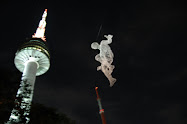
Written on a Saturday morning from the corner of the busiest street in my city.
Traffic goes four lanes each way. An endless supply of taxis and buses rush by—-even in this relatively small Korean city the traffic is thick. Little space for more cars, the population fills in the margins. Scooters, bicycles and motorcycles race through the cracks of the car, bus and truck traffic. Delivery drivers cut time by disobeying the traffic signals, as do the rest of the two-wheel transport drivers.
Shade drapes the bench but heat and humidity permeate. It’s about 88 degrees and feels like 95. I’m drinking a Vitamin C drink from the pharmacy behind me. I haven’t been able to adapt to the air quality so I try to keep my diet healthy and my vitamin levels high. Working with children and breathing this air, it’s good to try and prevent colds before they come on.
On the side street, I watch people wait four minutes to cross the street, whether or not cars are coming. Koreans follow the rules, and as illogical as it seems to this North American, they will not cross against the light.
A woman walks past with a parasol. The women began walking with the sun-umbrellas in May, when it got warmer. They protect against the sun to prevent tans. In fact, often the sunblock they wear doubles as skin protection and skin whitening cream. A few blocks from where I sit, a woman works in a convenience store with a white painted face.
As I’m sitting on this bench, the family of one of the Kindergartners—-Uni is her name—-at my school stops directly in front of me and motions me to their car. Through the window, her mother gives me two handfuls of homemade cookies! No joke. What kindness!
Elderly men and women ride past in bicycles. A man in his ‘70s, wearing white gloves and a sun-hat, rides a scooter past on the sidewalk, holding a walking cane against the handlebars and a bag of groceries between his legs. I wonder what he thinks of all this growth, rapid industrialization and increasingly prevalent influence from the West.
Jeonju built its first McDonald’s around the turn of the century. Now, there are two Golden Arches, an Outback, Pizza Hut, T.G.I. Friday’s, and various other Western restaurants and retail stores. I have seen America’s capitalism change the landscape of my own country, but the change must be more acute for Koreans.
The Korean economy has been strong for successive years and the cars that pass are newer Kia, Hyundai and Ssanyong. The peculiar aspect of the cars is that, stopped at this intersection, I count roughly 40 cars and vans (not many trucks—-not enough space) and nearly all of them are white, black or silver.
I was told that a few years ago the car manufacturers released a line of primary-colored cars but they didn’t sell. The companies give the customers what they want, and they want the three neutral colors.
Then, a college-age female passes wearing a pink shirt that reads Hollywood. I am near a university and many of the passers-by are college students. They are well-dressed and stylish. No one wears old clothes—-no holes and no stains. They look as though an MTV wardrobe crew dressed them. As is true in the U.S., television plays a strong role in their culture and sets standards for self-image. However, young people in the U.S. look shabby and lazy in comparison.
The sun moves overhead and we’re getting hungry. The Koreans are headed to restaurants for kimchi jjigae or kamjatang. Me, I’m going to sit here a little while longer and hope for some more homemade cookies.





